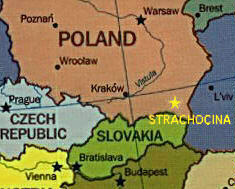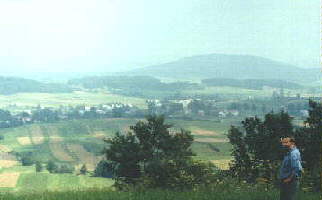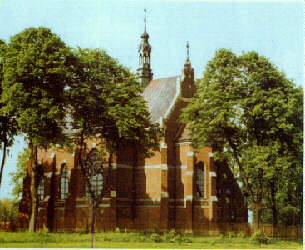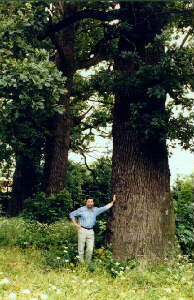
Strachocina - native village of
Saint Andrew (Andrzej) Bobola.
Strachocina is a relatively big village in the East Małopolska -
the east-southern part of today's Poland.
It belongs to the Podkarpackie voivodship (county)
with the capital in Rzeszow.
In earlier, "historical" times the region was called Ziemia
Sanocka (The Land of Sanok). Its capital was Sanok - still
the biggest town in the close neighborhood.
Strachocina is situated almost seven miles
west from it.
Ab. 300 houses, 1100 inhabitants, 1200 ha.
The picture shows panorama of the village seen from Góry Kiszkowe
(Hills of Kiszkas).
 Founded in 1369, perhaps as "Szwanczyce" (Święcice - ?).
Foundation act, issued by the king Casimir the Great is dated on May 10. 1369.
Further history of the village is very unclear.
At the place of today's Strachocina once there were
as much as four (!) villages: Strachocina, Strachocina Wola,
Szwanczyce and Meszewa.
Founded in 1369, perhaps as "Szwanczyce" (Święcice - ?).
Foundation act, issued by the king Casimir the Great is dated on May 10. 1369.
Further history of the village is very unclear.
At the place of today's Strachocina once there were
as much as four (!) villages: Strachocina, Strachocina Wola,
Szwanczyce and Meszewa.
Local tradition has it that there lived three kinds of
people in the village:
serfs (persons in a condition of feudal
servitude, required to render services to a lord and attached to
the lord's land), tenants of the
estate and szlachta zaściankowa
(village noblemen) (the latter were something like English gentry).
 The Bobolas were (in XVI-XVII centuries) tenants of the estate.
At the place of former residence of the Bobolas called now
"Bobolowka"
there is a park with ancient trees today.
In a field chapel that was built in 1990s there are celebrated solemnities dedicated to
Saint Andrew.
The Bobolas were (in XVI-XVII centuries) tenants of the estate.
At the place of former residence of the Bobolas called now
"Bobolowka"
there is a park with ancient trees today.
In a field chapel that was built in 1990s there are celebrated solemnities dedicated to
Saint Andrew.
At the border of the village there is a parish church
of St. Catharina from the turn of XIX and XX centuries - the place
of cult of St. Andrzej Bobola.
Near it one can find a monument of the Saint,
600-years old oaks, a St. Maximilian
cloister for Nuns
and a new-built pilgrim's hostel.
The church is neo-gothic.
It is situated in the place of original church founded (or only endowed)
in 1390 by Frederick Myssnar the tenant
of Jacmierz and Pakosz the tenant of Pakoszowka (villages in neighborhood).
The deed of donation for the church (see excerptions) is dated on the day of St Valentines
(it was Saturday that year).
|
 The identity of the place is evidenced by details of the deed of donation
as well as by ancient oaks that grow close to today's church.
The identity of the place is evidenced by details of the deed of donation
as well as by ancient oaks that grow close to today's church.
Photograph shows one of the least thick of them.
(Remaining trees grow at fenced ground out of the photographer's reach)
No doubt that they remember the first church in Strachocina.
It (or another wooden church build at the same place later) was burned-out in 1624 during
incursion of Tartars commanded by Kantymir Bey.
Together with the church the parish-priest Adam Majstroga was burnt too.
All villages (including Strachocina) in the area were destroyed,
their inhabitants killed or abducted.
The only remembrance of those old times - apart from the ancient oaks -
is a gothic
baptismal basin at the St Andrew's altar
(adored for its supposed pertaining to St Andrew).
In the place of the burnt church a new one was built, but only in 1756, after 132 years:
|
Since the end of 1980s Strachocina has been the local center of the cult of St Andrew Bobola. Each May 16 there are celebrity attended by numerous pilgrims.
In woods of Strachocina (partially seen on the picture above) there is a natural gas mine - now used as an underground tank (the biggest in Europe - ?) for natural gas bought in Russia.
In Internet
Strachocina
is mentioned (February 1999) on Home Page of
Gmina
Sanok.
(Gmina = civil parish)
See also interactive
map of tourist attractions of Gmina Sanok
(Strachocina is one of the most important among them).
Everything in Polish only (alas).
E-mail address to the local Primary School:
strachocina@halicz.com.pl
(but don't be hopeful that they will answer your message)
 Updated: March 1 1999
Updated: March 1 1999